

Module 6: Blast off!
You’re officially ready for your final blast off! Like every great rocket engineer, you have worked very hard to achieve great success. Let’s celebrate your achievements by watching your rocket soar through the air on its final flight.
Improve
Now that you’ve mastered Newton’s laws, it’s time for the last step in the engineering design process – improve.
You’ve tested and launched your rockets multiple times to work out the best water level, and design. The ‘improve’ stage is about using all your knowledge and data to improve your rocket before its final flight.
A safe landing
Real rockets come equipped with parachutes to slow the spacecrafts down when they’re landing. You could add a parachute to your nosecone to make sure your rocket glides safely down to earth.
You have an example parachute in your kit – but how could you make one of your own?
You’ll need to think about how you keep it from moving inside the nosecone when it flies and how the parachute will engage once in the air.
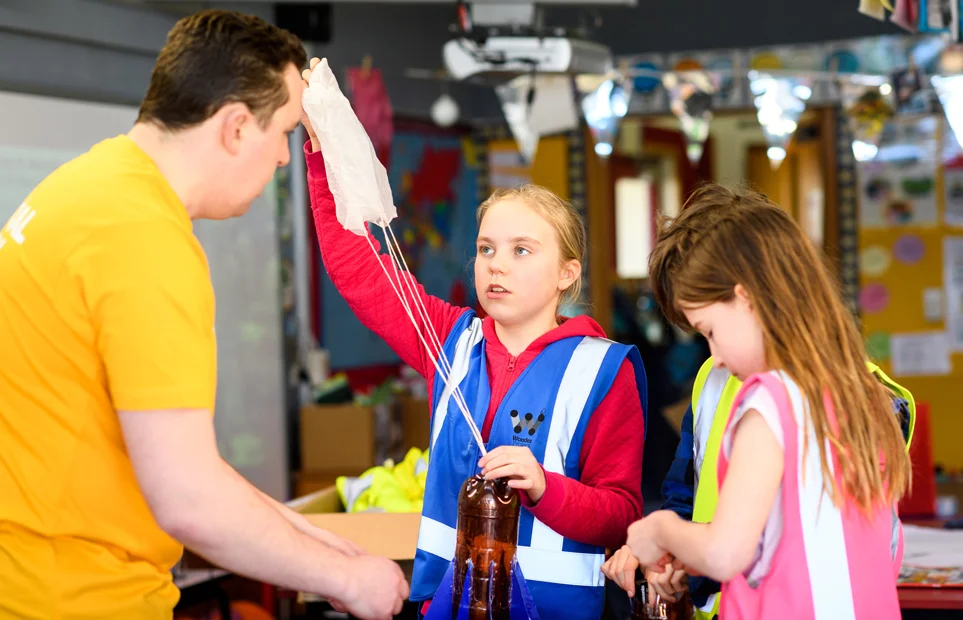
Mission Brief 11: Improve
You’ve got a working rocket prototype which means your rocket has flown successfully. Let’s use everything you’ve learned so far to achieve the ultimate rocket flight.
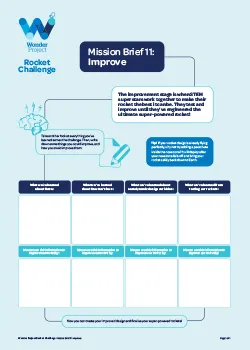
Ngā tohutohu mō te Whāinga 11:
Kia kaha te whakapai ake
Kei te pai te haere a tō tauira whakamātau tākirirangi, arā, kua tika te rere a tō tākirirangi. Whakamahia ngā akoranga katoa kua mau i a koe, ā mohoa nei kia tutuki ai tētahi rerenga tākirirangi mutunga mai o te pai.
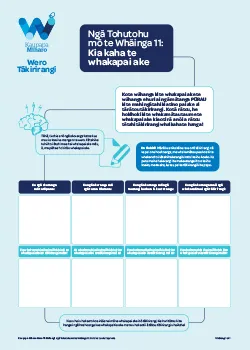
Final flight
Now you’ve all created the ultimate, high-performing rockets, it’s time to send them into the sky for the last time!
For the final flight, we’re going to record the distance your rocket travels (from the launcher to the landing site) and the time your rocket was in the air. This will tell us which crew’s rocket had the most successful flight.
Make sure the launcher angle is at 45° for each flight so you can measure the distance each rocket travels accurately.
Before you head out to the launchpad, don’t forget to:
- Revise the health and safety rules
- Remind yourself of your crew role
- Assign someone to video your test flights
- Assign someone to time how long your rocket was in the air
- Assign someone to record the distance your rocket travelled
- Bring a copy of Mission Brief 12 and a pen to collect your final flight data!
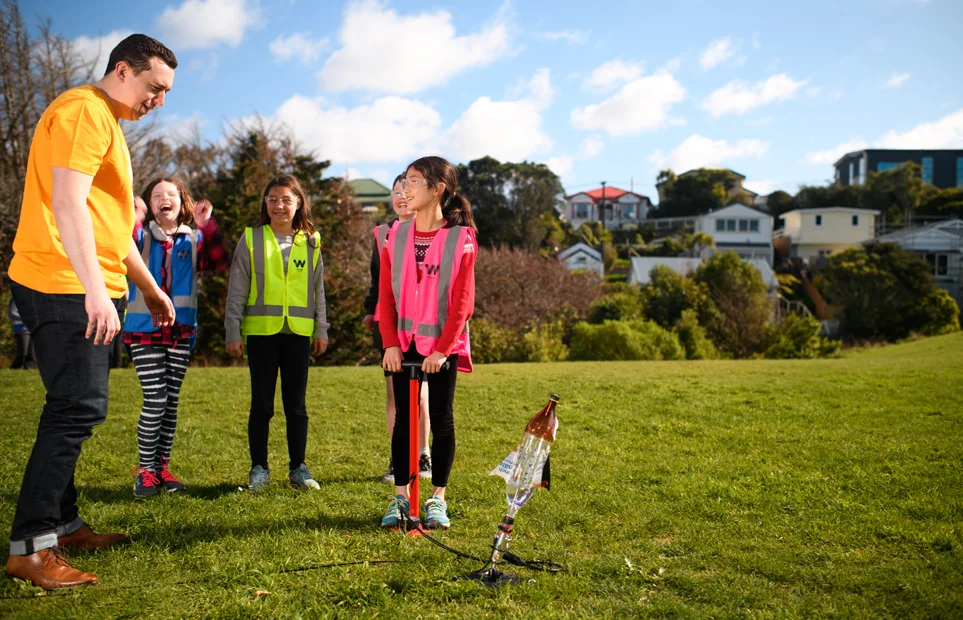
Mission Brief 12: Final flights
3-2-1... lift off! You’ll need every member of your crew to help on this Mission Brief including your Mission Command. Your Mission Command will help record your launches. Select the best result from your school and get your Mission Command to share it on the Facebook group.
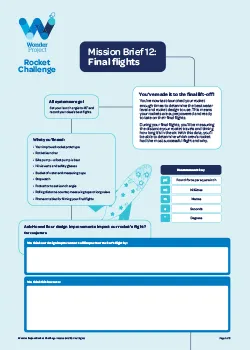
Ngā tohutohu mō te Whāinga 12:
Ngā rerenga whakamutunga
Toru, rua, tahi... rere whakarunga! Me mahi ngātahi te rōpū katoa i tēnei Whāinga, tae atu ki tō Kaitohutohu Whāinga. Ka āwhina tō Kaitohutohu Whāinga ki te tuhi i ngā putanga mō ngā whakarewanga. Kōwhiria ngā putanga pai katoa i tō kura, ā, mā tō Kaitohutohu Whāinga e tuku mai ki te rōpū Pukamata.
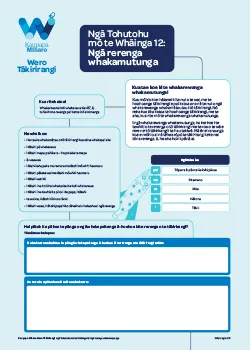
You might like to measure the trajectory of your final flights if you didn’t get around to it in the last module.
Use one of the videos you took of your final flight to complete this optional activity:
Congratulations!
It takes a team a lot of time to develop and successfully launch a rocket. Your crew has worked hard over the challenge to achieve mission success. Well done!
Take a moment to reflect on everything your crew has learnt – both your successful launches and your epic fails taught you important things!
Whānau showcase
Organise a time and invite your whānau along to school to showcase your rockets, what you learnt, and let them experience some epic rocket launches! They'll be amazed at what you have achieved.
You might also like to create a mini competition. You could consider which rocket looks the best, went the furthest, was up in the air the longest, and had the best performance overall. Do a demonstration in front of your class or whānau and get them to choose the winner.
Update your sticker chart
Have you completed all the Mission Briefs for this module? Don’t forget to put a sticker on your chart!
I wonder how to tell our story?
Bring your Rocket Challenge story to life by creating an epic video or poster for the final blast-off competition. Make sure you follow these guidelines to be in to win a sweet prize for your school:
- Be clear rather than clever to help your audience understand your story
- Video guidelines:
- Plan the beginning, middle and end of your video
- Think about sound, visuals and script
- Make sure it’s no more than 3 minutes long.
- Poster guidelines:
- Plan the poster layout so it’s organised and easy to follow
- Think about how to use graphics and visuals to enhance presentation.
Send in your entry by 7 August
Get Mission Command to send a copy of your video or poster to the Wonder Project Community Facebook Group, or to wonder@engineeringnz.org
Mission Brief 13: Blast off competition
Create a video or poster that tells the story of your Rocket Challenge journey and go in the draw to win a sweet prize.
Need some inspiration?
Check out the 2022 Rocket Challenge video winners from Maungatapu School
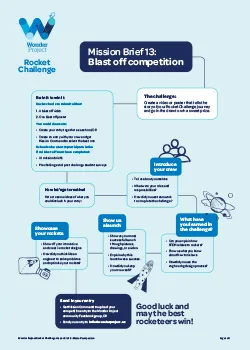
Ngā tohutohu mō te Whāinga 13:
Te whakataetae rerenga whakamutunga
Hangaia tētahi ataata, tētahi whakatairanga rānei e whakaatu mai ana i ngā kōrero mō ngā mahi i whāia, i oti anō hoki i a koutou i te Wero Tākirirangi, ā, ka whakawhiwhia pea koutou ki tētahi taonga pai.
Kei te rapu whakaaro koutou?
Tēnā, tirohia ngā toa o te Wero Tākirirangi i te tau 2022 nō Te Kura o Maungatapu

Post-challenge survey
Now’s the time to tell us what you thought of the Rocket Challenge! When you complete our survey, it helps us to make the challenge even better for next time.
You can tell us all the good bits, the bad bits and what you think could be better for next time.
Module 6 checklist
- Completed Mission Brief 11: Improve
- Completed Mission Brief 12: Final flights
- Completed student post challenge survey
Optional – Measuring trajectory activity
Optional – Mission Brief 13: Blast off competition